Instructional Strategies for Autism
5 Tips That Work!
Although there are no silver bullets for teaching students with Autism, there are several strategies that will get you a higher rate of success. Believe me, if you’re not doing these things… you’re doing it wrong. As you reflect on your teaching, ask yourself how successful you are at providing the following 5 instructional strategies for autism with students in your classroom.
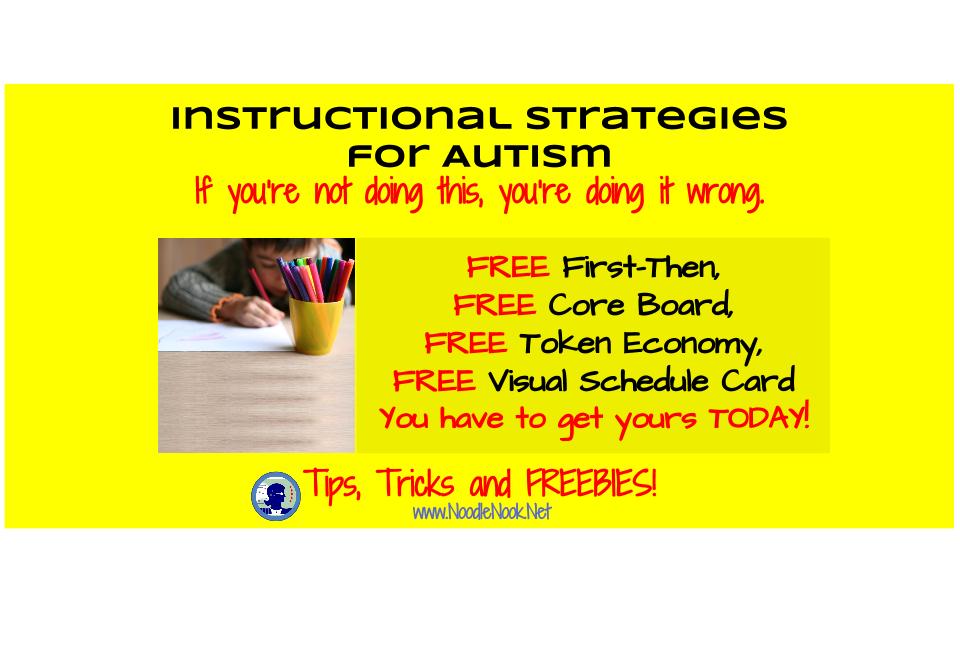 #1 Instructional Strategies for Autism:
#1 Instructional Strategies for Autism:
Have Environmental Controls
There are a lot of things to consider when you set up a classroom- and that goes for any teacher. When you are teaching students with Autism,however, you must be even more deliberate with your choices. You want to set your room up for success, be sure to do the following:
- Do not isolate a student by only offering them one place and one place only to sit all day long. Be sure you classroom has flexible seating for different purposes including large group, small group, independent and individual (where the student works directly with you). That flexible seating will allow you to be ready for whatever needs you have with a student- without locking them away.
- Be sure to set up work stations that have everything a student will need to be successful. That will likely include work tasks/academic materials, but also timers, visual reminders, and a clearly organized system for to-do and ta-done.
- Remember to include an area that can be designated as a break area or rest area- the lone designation will make it easier to teach when break is happening and, more importantly, when break is over.
#2 Instructional Strategies for Autism:
Use Visual Schedules & Structured Routines
I am a creature of habit. I get up about the same time every day, go through the same morning routine doing things like brushing my teeth, getting dressed, and eating my usual breakfast. When something breaks that routine, I am totally off (like leave the house without my lunch or with shoes that don’t match). Why do you think it would be different for students? All students, not just students with Autism, do better if they know what is coming and can prepare. So, with that in mind, be sure to:
- Have a clear and predictable routine in the classroom. Although I never suggest being married to a specific time (teach students -ish as in 9:15ish so that you always have wiggle room), there should be a routine in place. If possible, the activities in the class are familiar and a student always knows what is coming and what they are expected to do. That does NOT mean they do the same thing every day… but if you used a Venn Diagram to discuss similarities and differences related to whatever your instructional focus was during large group, then that routine would be developed, even if the topic being discussed changed regularly. Routine is not repetition. (Read more about Visual Schedules HERE.)
- Allow choice in the routine. Everyone wants to be the captain of their ship and the master of their mansion. Our student are no different. Build in choice throughout the day so your students are able to feel like they are actively involved and not passively going through their day.
- Visual Schedules are a must. That does not always include pictures per se- sometimes a written schedule will do… the point is there a something concrete to reference. And there are plenty of FREE visual schedule makers out there so you don’t have to do it on your own. Try this one from Cara Carroll (I literally cannot believe this 45 page pack is free). And you can read more HERE on Visual Structure in the classroom.
- Use wait time (read what Cookie Monster can teach you about wait time), token economies (see below for a FREEBIE), and first–thens (download yours below). The visuals don’t end at the schedule… and they don’t go away after the first week of school. Providing these visuals are the anchors that keep your student from drifting away. Not only do you need them, but you should be sure they have them in all other settings like large group, electives, and specials.
- Match your verbal directions with visuals- or gestural instructions. You don’t have to be fluent at sign, but using a gesture to remind a student of what you mean with all the verbal instructions coming out of your mouth is very helpful for Autistic students who typically have a auditory impairment- It will get them going a little faster. If you can’t include visuals in everything you do, replace some with gestural cues.
Get your FREE Token Economy to start using today by downloading the Preview HERE! A great visual to get you mastering instructional strategy #2~Visual Schedules & Structured Routine! And don’t forget your FREE First-Then
–> CLICK HERE FOR THE FREEBIE! <–
–> CLICK HERE FOR THE FREEBIE! <–
#3 Instructional Strategies for Autism:
Teach A Communication System
This is the one most people gloss over. I love this video when it comes to what it actually looks like when you are correctly modeling language with a student who uses an alternative communication system:
No matter what system you go with , you have to model what that looks like. There are those you use with iPhones and iPads or tablets, like the FREE App GoTalkNow Lite from Attainment. If that is not possible in your instructional setting, try low-tech alternatives, like PECS, this FREE Core Board, or even the flip communication system here that offers conversational communication.
The biggest thing to remember, no matter which system you use, is that:
- It should always be present and available to use, no matter what.
- You will need to model, model, model how to use it correctly.
- Too many symbols is sometimes overkill. Use the 300 word approach (the three hundred most common words do over 90% of the communication one needs).
- And don’t forget… as a teacher, use simple, concrete language without sarcasm, idioms (it’s raining cats and dogs) or with open ended choice.
BONUS: Get your FREE CORE BOARD (people- I used this every day I taught after I found it… and it’s free!) and also read what the great people at UNC consider the hierarchy of AAC word instruction by clicking here.
[tweetthis]Free Core Board, Free First-Then, Free Visual Schedule, Free Token Economy-Get yours NOW!![/tweetthis]
#4 Instructional Strategies for Autism:
Practice Social Skills
I used to have a student who, in his first interactions with a colleague of mine, told her she was too fat in the belly and should take Lipozene. The first time they met. Awkward. And that is the number one complaint of possible employers when they try to hire LIFE Skills and Autism unit students- they lack social skills. We must teach them! It is part of our job.
Where do you start? Well, you have to assume there is no such thing as common sense… you will have to teach each nuance of social grace. How do you do that?
- Include Social Stories in your regular instruction. This will allow a student to hear what is supposed to happen and what they are to do prior to the real deal. It come to be great blueprints to appropriate behavior before the next step of…
- Role Playing and modeling. You should have plenty of situations where students can role play how to behave in an array of social situations, practice getting things wrong and getting feedback. You will also want to model great social behavior for your students.
- Don’t forget to focus on soft skills too, like turn taking, self management and waiting too! I had a student who, I think, never stood in line for anything (before me). He always got taken to the cafeteria first and never had to wait in line. Out in the community, people got things for him and he never stood in line there either. When we would actually go out in the community, he was shocked to have to wait! And he was a pretty high functioning kid. We have to teach waiting and self-management as part of our instruction too. Check out this post for more on teaching social skills.
- And, finally, don’t forget meaningful contact with peers. Our students should not be locked away somewhere only seeing other students from their same program all day everyday. Allow controlled social interactions in the classroom, in the school’s common area, and in regular education settings too so your students get a chance to generalize the skills you’ve been working so hard on.
#5 Instructional Strategies for Autism:
Understand the Sensory Piece
There was a young man I taught for several years who still has a place in my heart. When he came to me, he almost always used his hands to cover his ears. When he needed to hold something, he used his shoulder to cover his ears while his hands got a break (usually to eat). At the time I had a para who was pretty new to students with Autism and, for some reason, him covering his ears irked her. She was always on him to stop and put his hands down.
Well.
I had the conversation with her several times- that behavior is part of his disability, but she never quite got it. Then I showed this video and it clicked with her:
This started in the middle of the video to highlight headbanging and ear covering, but please watch the entire video.
After the result I got with this particular para, I started using this video every fall with my team to start the year. It was a great reminder that sensory overload is real with students with Autism. And they cannot help it.It really can be a sound, a smell, or too much visual input. When it comes to sensory stimulation, think of a student with Autism being more sensitive than you are. So, it becomes essential to include the following in your instruction:
- Avoid over-stimulation– sensory overload is real.
- Recognize when a student is feeling anxiety and allow for them to access a break… and sometimes that includes accessing their obsessive behavior (rocking, items, sensory stim) as a reward for positive efforts.
- And schedule in breaks– especially a break from sensory input.
Well, there you have it. These are the 5 keys to teaching students with Autism… the teaching strategies you need to be successful. I can guarantee that if you do these things, you will be more successful with your students, have less violent behavior in your classroom, and be happier in your role as a teacher.
Do you do some of these things? Comment below on how that helps you in your classroom.
>>PIN ME NOW an SHARE!<<

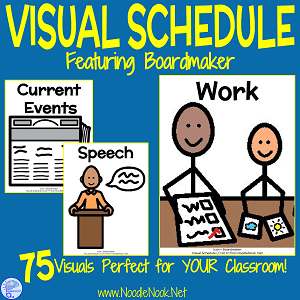

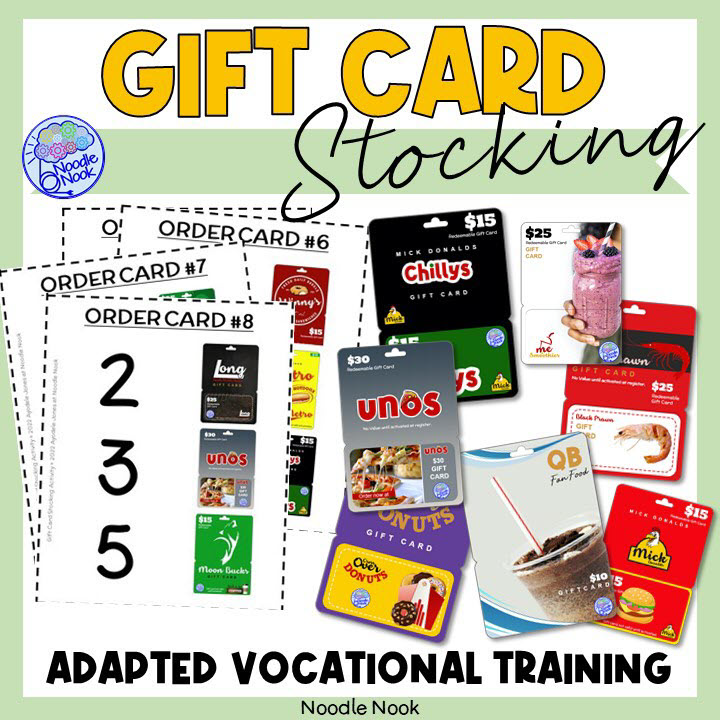
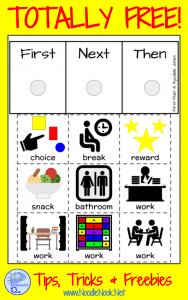
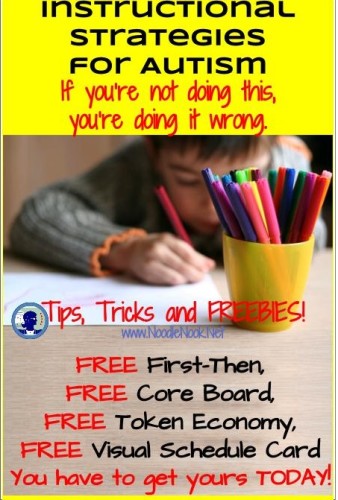
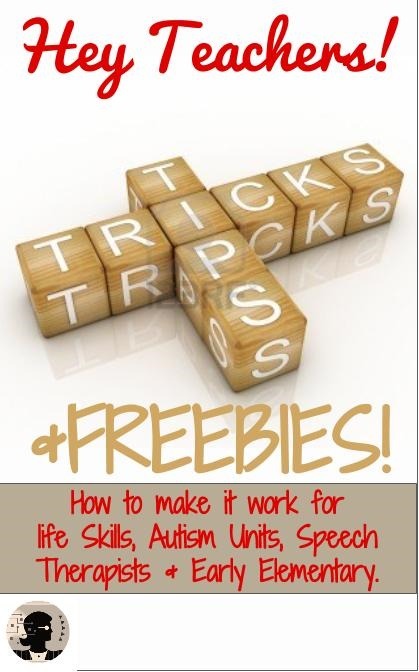
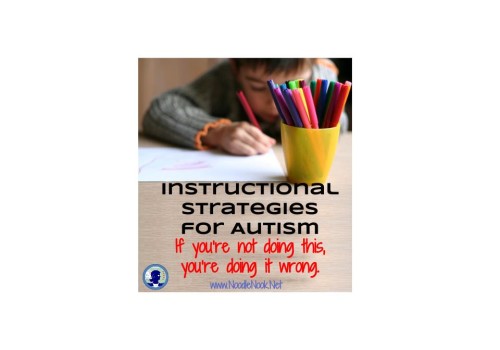
AMAZING Post! thanks for share… waiting for more!
Does your website have a contact page? I’m having problems locating it but, I’d like to send you an email to see if you can do training at my campus! You’ve got a great blog and I look forward to seeing what’s next!
It’s challenging to find well-informed people on this matter, but you seem to what you’re talking about! Lots of great tips on working with AU kiddos.
Thanks!
Comments are closed.